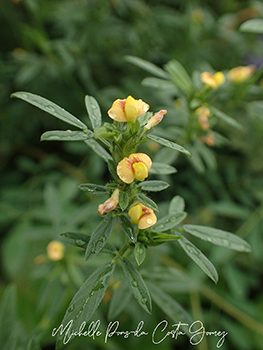This post is also available in: Dutch (below)

This wild flower of Curaçao is as tiny as 5 mm long and often even smaller, but with the characteristic shape that is so familiar in the Fabaceae family or bean family as it is popularly called.
The Pinda shimaron is also called Wild clover or Stylo in English and is a native plant of the Caribbean. As a nutritious crop it has been introduced in several countries in the world where it is being used a cattle food as well as manure for agricultural areas. The plant itself is a herblike plant with small dark green leaves that are almost always in a set of three together.
In the wild this plants is known to be eaten by lizards, iguanas, deer and Cottontails.
English name: Wild clover/ Stylo
Papiamentu/Papiamento name: Pinda shimaron
Scientific name: Stylosanthes hamata
Family: Fabaceae (Legume family)
Occurrence (ABC islands): Aruba, Bonaire and Curaçao

Wilde bloemen – Pinda shimaron

Deze wilde bloem van Curaçao is slechts 5 mm lang en vaak nog kleiner, maar heeft de karakteristieke vorm die zo bekend is in de vlinderbloemenfamilie (Fabaceae), zoals hij in de volksmond wordt genoemd.
De Pinda shimaron wordt ook wel wilde klaver of Stylo genoemd en is een inheemse plant uit het Caribisch gebied. Als voedzaam gewas is hij in verschillende landen geïntroduceerd, waar hij wordt gebruikt als veevoer en als meststof voor landbouwgebieden. De plant zelf is een kruidachtige plant met kleine donkergroene blaadjes die bijna altijd in een setje van drie bij elkaar staan.
In het wild wordt deze plant gegeten door hagedissen, leguanen, herten en Cottontails.
Nederlandse naam: Wilde klaver
Papiamentse naam: Pinda shimaron
Wetenschappelijke naam: Stylosanthes hamata
Familie: Fabaceae (vlinderbloemenfamilie )
Voorkomen (ABC eilanden): Aruba, Bonaire en Curaçao